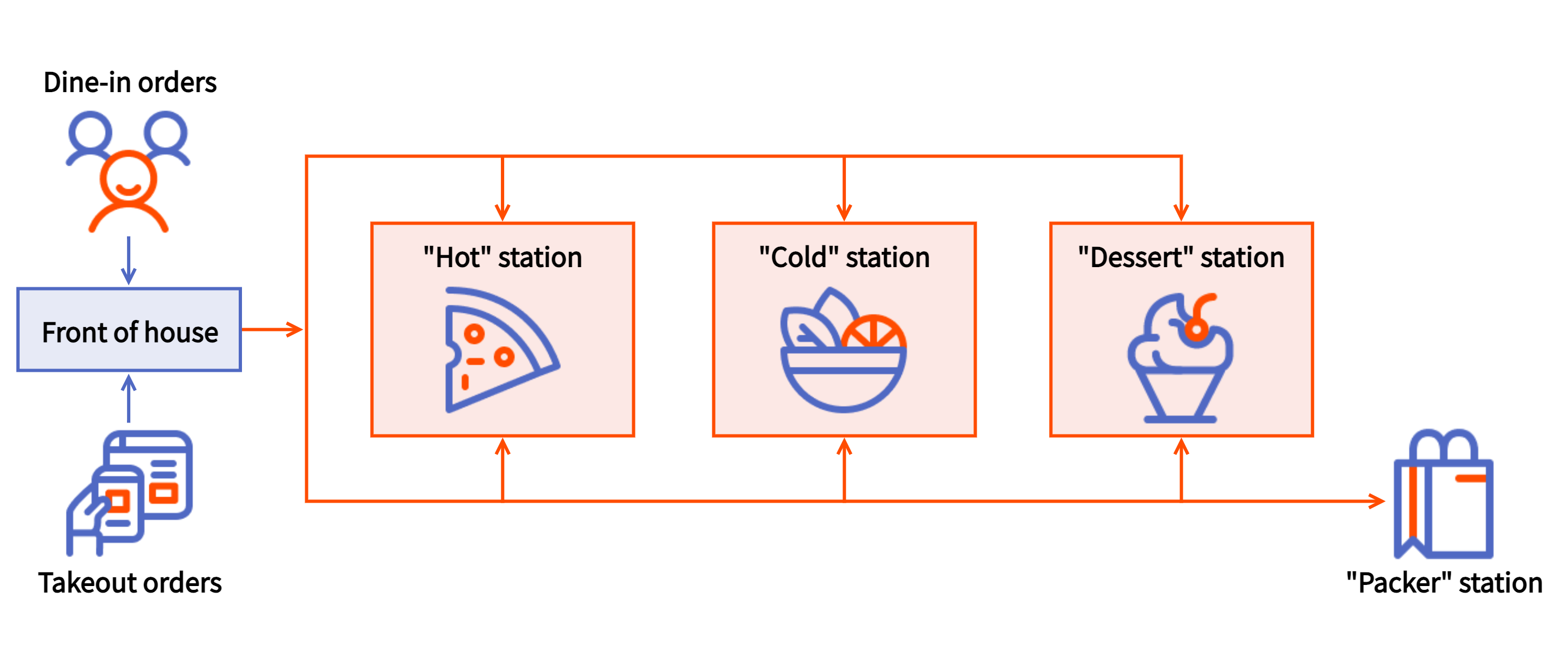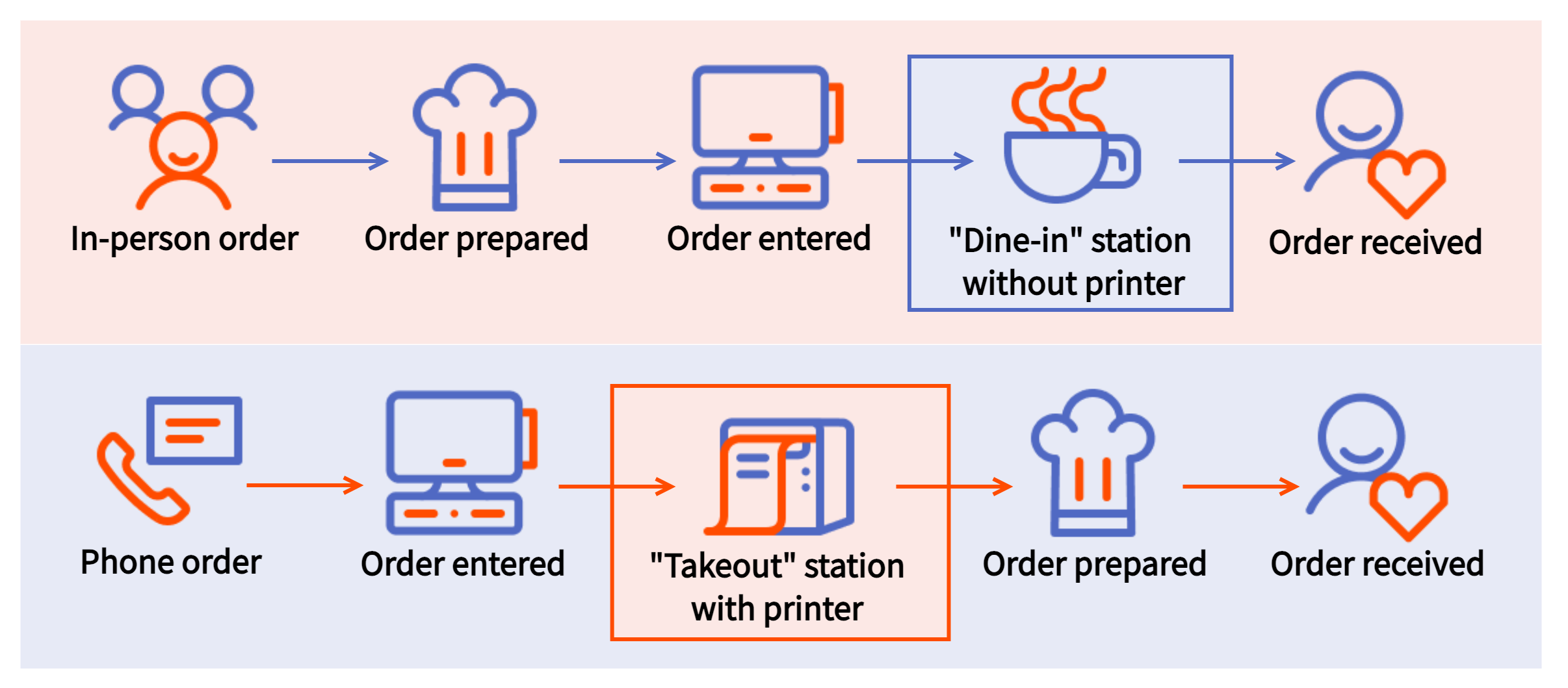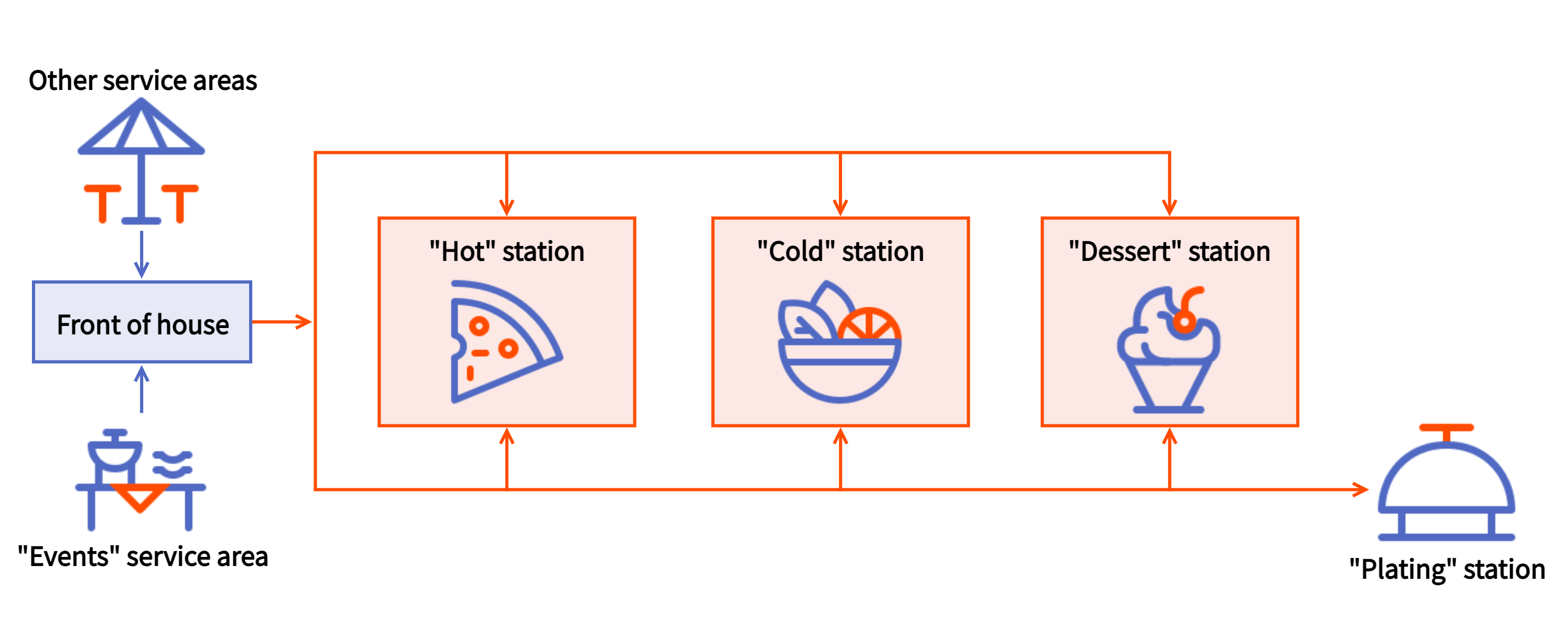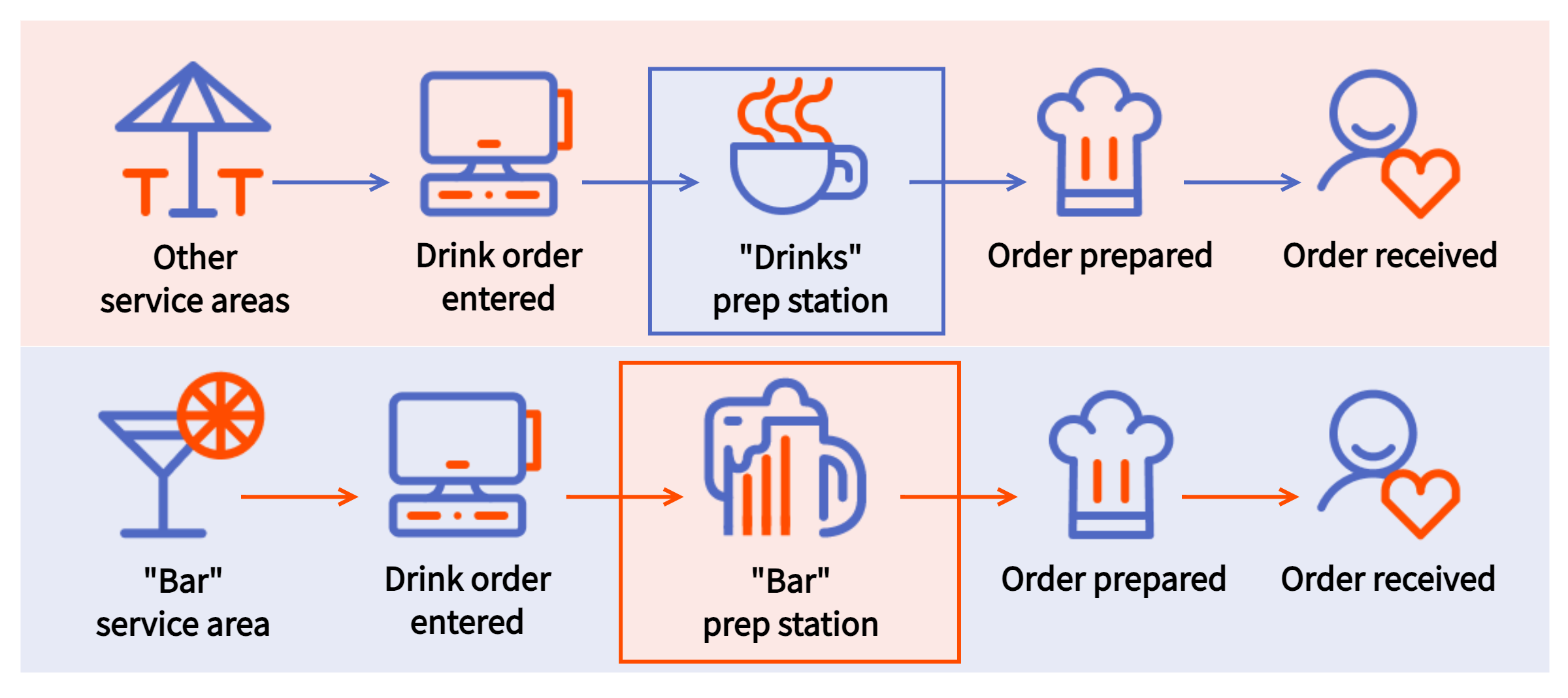An item routing rule defines a condition for an order that, if met, requires a change to the order fulfillment workflow. The conditions are the dining option of the order, or the service area.
|
Note |
|
To create item routing rules, you must have the 6. Web Setup > 6.2 Kitchen / Dining Room Setup permission. |
After specifying the condition for your rule, you then define how you want the workflow to change.
-
Specify a single prep station to reroute items from. This is the prep station that you want to reroute items from when a condition is met. Set up a separate rule for each "from" prep station that needs a workflow change. For example, you select a prep station that is currently getting tickets for takeout orders.
-
Specify one or more prep stations to reroute items to. This is the new prep station or stations that you want the item to be sent to once the condition is met. You can specify more than one prep station, including the one that currently fulfills the orders.
As soon as you publish the item routing rule, the Toast platform applies the rule to all items in an order that meet the specified dining option or service area condition.
|
Note |
|
If you use the Dining Option additional modifier group to identify a different dining option for an item in an order, that item is routed to the same prep stations as the other items in the order. |
The dining option that guests select for their meals can have a significant effect on which, and how many, prep stations are involved in fulfilling the order. With the Toast platform, you can set up item routing rules that change the way items are routed for fulfillment based on the dining option specified. This means sending the item to an additional prep station or a completely different prep station, depending on the dining option.
For more information about how you configure dining options, see Dining Options.
You can also use KDS devices to display tickets only for specified dining options. For more information, see Filtering tickets on a KDS device.
One way to change item routing based on dining option is to add an additional prep station for items to be assigned to. For example, this occurs when a particular dining option requires an extra step or process.
For example, you add an employee to package takeout orders and set up a Packer prep station in the kitchen alongside the original Hot, Cold, and Dessert prep stations. You then add item routing rules that send takeout orders to the Packer prep station in addition to the Hot, Cold, and Dessert prep stations.

This requires three different item routing rules for each prep station when the dining option for an order is takeout:
-
Rerouting items sent to the Hot prep station to be sent to the Hot and Packer prep stations.
-
Rerouting items sent to the Cold prep station to be sent to the Cold and Packer prep stations.
-
Rerouting items sent to the Dessert prep station to be sent to the Dessert and Packer prep stations.
You do not need to add item routing rules for dine-in orders, because that dining option does not require additional or different prep stations.
Another way to change item routing based on dining option is to change which prep station receives orders. For example, you have a quick service restaurant. Guests can place orders in person and receive them immediately at the counter or over the phone and then pick them up at a scheduled time.
To accommodate both dining options as efficiently as possible, your kitchen has two identical prep stations, one to fulfill in-person (dine-in) orders and the other for phone (takeout) orders. The item routing rule sends takeout orders to the Takeout prep station. The default behavior is to send items to the Dine-in prep station.

For in-person orders, the line cook interacts with the guest to fulfill the order. Therefore, tickets do not need to be printed for the Dine-in prep station. For phone orders, because the guest is not there to work with the line cook, the order is printed at the Takeout prep station.
You can also choose to change how items are routed based on the service area. Item routing rules can be set to change the prep stations items are routed to when sent from a specified service area. This means sending an item to an additional or completely different prep station, depending on what you need for each service area.
For more information about how to configure service areas, see this Toast Central article.
You can also use KDS devices to display tickets only for specified service areas. For more information, see Filtering tickets on a KDS device.
One way to change item routing based on service area is to add an additional prep station for items to be assigned to. For example, this occurs when a particular service area requires an extra step or process.
For example, you have a full service restaurant that has a separate room for private events. This room uses the service area Events. When items are made for this service area, items typically shared for a table should be plated individually. You add an item routing rule that sends these shared items to a Plating prep station in addition to the original Hot, Cold, and Dessert prep stations.

This requires three different item routing rules for each prep station when the service area is Events:
-
Rerouting items sent to the Hot prep station to be sent to the Hot and Plating prep stations.
-
Rerouting items sent to the Cold prep station to be sent to the Cold and Plating prep stations.
-
Rerouting items sent to the Dessert prep station to be sent to the Dessert and Plating prep stations.
You do not need to add item routing rules for other service areas, because those service areas do not require additional or different prep stations.
Another way to change item routing based on service area is to change which prep station receives orders.
For example, you have a full service restaurant that includes a Bar service area on another floor. You want drinks entered at the Bar to be prepared by the Bar prep station, while drinks at other service areas to be prepared at the Drinks prep station in the kitchen. The item routing rule sends items originally sent to the Drinks prep station to the Bar prep station when the service area is Bar. The default behavior for all other service areas is to send items to the Drinks prep station.

For all other service area orders, the items should be prepared at the Drinks prep station, therefore items do not need to be routed to a different prep station.
Before creating item routing rules, make sure that you configure any prep stations, dining options, or service areas you need, and assign prep stations to your menu entities. Take into consideration the following:
-
How many prep stations you will need to reroute from. You can only choose a single prep station to reroute from in an item routing rule.
-
How many dining options or service areas you need to create item routing rules for.
The number of prep stations you need to reroute from for each dining option or service area determines how many item routing rules you need.
Once you determine which prep stations you want to reroute and where you want them to reroute to and for which dining options or service areas, you can add your item routing rules.
To create item routing rules
-
Choose Kitchen > Kitchen stations > Item routing.
-
Select the + Add button. A row is added to the interactive table.
-
Enter an identifying name for the rule.
-
Set the Category for the rule. This is either:
-
Dining Option
-
Service Area
-
-
From the Condition list, select the dining option or service area that your rule applies to.
-
From the Reroute From list, select the prep station that you want to reroute items from.
Note
You can only select one prep station from this list.
-
From the Reroute To list, select the prep station or stations that should recieve the tickets when the condition is met.
For example, you can choose a different prep station, or additional prep stations. If you want to add additional prep stations, remember to include the original prep station you selected in the previous step.
-
Save and publish your changes.
The Toast platform immediately begins routing tickets to the new or additional prep stations when the condition is met.